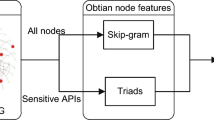Abstract
With the rapid development of mobile Internet, mobile devices have been widely used in people’s daily life, which has made mobile platforms a prime target for malware attack. In this paper we study on Android malware detection method. We propose the method how to extract the structural features of android application from its function call graph, and then use the structure features to build classifier to classify malware. The experiment results show that structural features can effectively improve the performance of malware detection methods.
Access this chapter
Tax calculation will be finalised at checkout
Purchases are for personal use only
Similar content being viewed by others
References
Enck, W., Octeau, D., Mcdaniel, P.: A study of android application security. In: Proceedings of the 20th Usenix Security Conference, p. 21 (2011)
Enck, W., Ongtang, M., McDaniel, P.: On lightweight mobile phone application certification. In: Proceedings of 16th ACM Conference on Computer and Communications Security, pp. 235–245 (2009)
Sarma, B.P., Li, N., Gates, C., Potharaju, R., Nita-Rotaru, C., Molloy, I.: Android permissions: a perspective combining risks and benefits. In: Proceedings of 17th ACM Symposium Access Control Models Technologies, pp. 13–22 (2012)
Peng, H., Gates, C., Sarma, B., Li, N., Qi, Y., Potharaju, R., Nita-Rotaru, C., Molloy, I.: Using probabilistic generative models for ranking risks of Android apps. In: Proceedings of ACM Conference on Computer and Communications Security, pp. 241–252 (2012)
Kim, S., Cho, J.I., Myeong, H.W., Lee, D.H.: A study on static analysis model of mobile application for privacy protection. In: Park, J.J., Chao, H.-C., Obaidat, M.S., Kim, J. (eds.) Computer Science and Convergence. Lecture Notes in Electrical Engineering, vol. 114, pp. 529–540. Springer, Heidelberg (2012)
Zhou, Y., Wang, Z., Zhou, W., Jiang, X.: Hey, you, get off of my market: detecting malicious apps in official and alternative Android markets. In: Proceedings of the 19th Annual Network & Distributed System Security Symposium, February 2012
Hao, H., Singh, V., Du, W.: On the effiectiveness of api-level access control using bytecode rewriting in android. In: Proceedings of the ACM SIGSAC Symposium on Information, Computer and Communications Security (2013)
Kashima, H.: A linear-time graph kernel. In: Proceedings of the Ninth IEEE International Conference on Data Mining, pp. 179–188 (2009)
Gärtner, T., Lloyd, J.W., Flach, P.A.: Kernels and distances for structured data. Mach. Learn. 57(3), 205–232 (2004)
Schölkopf, B., Platt, J., Hofmann, T.: Fast computation of graph kernels. In: Advances in Neural Information Processing Systems 19 NIPS, pp. 1449–1456 (2006, 2007)
Shervashidze, N., Schweitzer, P., Leeuwen, E.J.V., et al.: Weisfeiler-Lehman graph kernels. J. Mach. Learn. Res. 1(3), 1–48 (2011)
Ding, Y., Yuan, X., Zhou, D., Dong, L., An, Z.: Feature representation and selection in malicious code detection methods based on static system calls. Comput. Secur. 30, 514–524 (2011)
Malware Geome Project. http://www.malgenomeproject.org
Acknowledgment
This work was partially supported by Scientific Research Foundation in Shenzhen (Grant No. JCYJ20140627163809422, JCYJ20160525163756635), Guangdong Natural Science Foundation (Grant No. 2016A030313664) and Key Laboratory of Network Oriented Intelligent Computation (Shenzhen).
Author information
Authors and Affiliations
Corresponding author
Editor information
Editors and Affiliations
Rights and permissions
Copyright information
© 2016 Springer International Publishing AG
About this paper
Cite this paper
Ding, Y., Zhu, S., Xia, X. (2016). Android Malware Detection Method Based on Function Call Graphs. In: Hirose, A., Ozawa, S., Doya, K., Ikeda, K., Lee, M., Liu, D. (eds) Neural Information Processing. ICONIP 2016. Lecture Notes in Computer Science(), vol 9950. Springer, Cham. https://doi.org/10.1007/978-3-319-46681-1_9
Download citation
DOI: https://doi.org/10.1007/978-3-319-46681-1_9
Published:
Publisher Name: Springer, Cham
Print ISBN: 978-3-319-46680-4
Online ISBN: 978-3-319-46681-1
eBook Packages: Computer ScienceComputer Science (R0)




